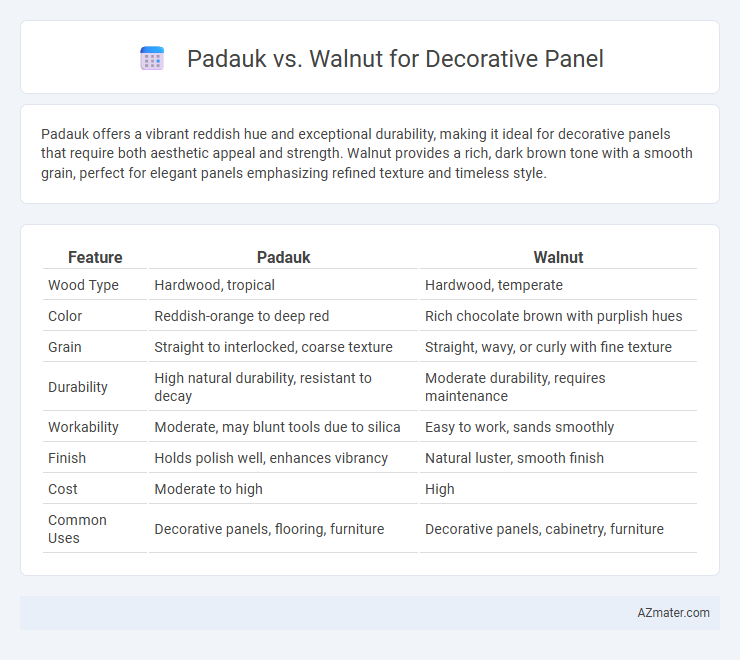Padauk offers a vibrant reddish hue and exceptional durability, making it ideal for decorative panels that require both aesthetic appeal and strength. Walnut provides a rich, dark brown tone with a smooth grain, perfect for elegant panels emphasizing refined texture and timeless style.
Table of Comparison
| Feature | Padauk | Walnut |
|---|---|---|
| Wood Type | Hardwood, tropical | Hardwood, temperate |
| Color | Reddish-orange to deep red | Rich chocolate brown with purplish hues |
| Grain | Straight to interlocked, coarse texture | Straight, wavy, or curly with fine texture |
| Durability | High natural durability, resistant to decay | Moderate durability, requires maintenance |
| Workability | Moderate, may blunt tools due to silica | Easy to work, sands smoothly |
| Finish | Holds polish well, enhances vibrancy | Natural luster, smooth finish |
| Cost | Moderate to high | High |
| Common Uses | Decorative panels, flooring, furniture | Decorative panels, cabinetry, furniture |
Introduction to Padauk and Walnut for Decorative Panels
Padauk wood, known for its vibrant reddish-orange hues and natural durability, is a popular choice for decorative panels that require a striking visual impact and long-lasting performance. Walnut offers a rich, deep brown color with smooth grain patterns, making it ideal for elegant, sophisticated paneling in high-end interiors. Both woods provide excellent workability and resistance to wear, with Padauk excelling in color retention and Walnut favored for its classic aesthetic appeal.
Visual Appeal: Color and Grain Comparison
Padauk features vibrant reddish-orange hues that deepen over time, creating a striking and warm visual appeal ideal for decorative panels. Walnut offers rich, dark brown tones with subtle purples and a smooth, straight grain pattern that provides a classic and sophisticated look. The contrasting color intensity and grain complexity between Padauk and Walnut allow designers to select based on boldness or understated elegance for interior decor.
Durability and Hardness Differences
Padauk exhibits exceptional durability and a Janka hardness rating of approximately 1,910 lbf, making it highly resistant to wear and ideal for decorative panels in high-traffic areas. Walnut, with a Janka hardness of around 1,010 lbf, offers moderate hardness and durability, suitable for less demanding environments where a smoother finish is prioritized. The superior hardness of Padauk provides better resistance to dents and scratches compared to the softer, more porous walnut.
Workability and Ease of Finishing
Padauk features a fine, even grain and moderate hardness, making it highly workable with hand and power tools, while Walnut's dense, straight grain also offers excellent workability but may require sharper blades for cleaner cuts. In terms of finishing, Padauk's natural oils can sometimes resist stain absorption but enhance natural luster with oil finishes, whereas Walnut accepts stains evenly and polishes to a smooth, rich finish. Both woods respond well to sanding and sealing, but Walnut's consistent texture often results in a slightly easier and more predictable finishing process for decorative panels.
Stability and Response to Climate
Padauk wood demonstrates superior stability in varying climates due to its dense grain and natural oils that resist warping and moisture absorption, making it ideal for decorative panels exposed to fluctuating humidity. Walnut, while also durable, tends to be more sensitive to changes in temperature and humidity, potentially leading to slight expansions or contractions in panel dimensions over time. For environments with significant climate variations, Padauk offers a more reliable performance, ensuring long-lasting structural integrity and aesthetic consistency in decorative panel applications.
Cost and Availability Analysis
Padauk offers vibrant reddish hues with moderate cost and is moderately available, often sourced from Southeast Asia, making it a mid-range option for decorative panels. Walnut, prized for its rich brown tones and fine grain, commands a higher price due to limited availability from North America and Europe. Cost analysis reveals walnut as a premium choice with potential supply constraints, whereas padauk provides a balance of affordability and accessibility for decorative applications.
Environmental Impact and Sustainability
Padauk wood, sourced from fast-growing trees primarily in Africa and Southeast Asia, offers a more sustainable option for decorative panels due to its quicker regeneration rate and lower ecological footprint. Walnut, favored for its rich color and grain, often comes from slower-growing trees in North America and Europe, making it less renewable and sometimes linked to deforestation concerns. Selecting Padauk over Walnut can reduce environmental impact by supporting sustainable forestry practices and minimizing habitat disruption.
Best Applications for Padauk Panels
Padauk wood is ideal for decorative panels in interior spaces requiring vibrant color and durability, such as feature walls, furniture accents, and cabinetry due to its rich reddish-orange hues and natural resistance to wear. Its stability and fine grain make it well-suited for high-end applications where aesthetic appeal and structural integrity are essential. Compared to walnut, which offers a more subdued, classic look, Padauk brings a bold, exotic touch that enhances modern and eclectic design schemes.
Ideal Uses of Walnut in Decorative Projects
Walnut is highly prized for decorative panels due to its rich, dark brown color with subtle purple hues and a smooth grain that adds sophistication to interior design. Ideal for luxury furniture, wall paneling, and high-end cabinetry, walnut enhances spaces with its elegant appearance and exceptional durability. Its natural resistance to warping and compatibility with various finishes make it perfect for both modern and classic decorative projects.
Final Verdict: Choosing Between Padauk and Walnut
Padauk offers vibrant reddish hues and exceptional durability, making it ideal for bold, statement decorative panels, while Walnut provides a rich, deep brown color with intricate grain patterns that suit sophisticated and classic designs. Both woods deliver excellent stability and finishing qualities, but the choice depends on the desired aesthetic and project environment. Selecting between Padauk and Walnut hinges on whether a striking, warm tone or a timeless, elegant look best complements the interior design.

Infographic: Padauk vs Walnut for Decorative Panel
 azmater.com
azmater.com